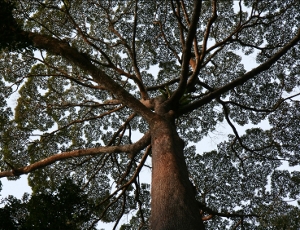
Products for NIMBioS Working Group:
A DEB Model for Trees
Publications
- Couvreur V et al. 2018. Water transport through tall trees: A vertically explicit, analytical model of xylem hydraulic conductance in stems. Plant, cell & environment 41(8):1821-39. [Online]
- Feng X et al. 2018. The ecohydrological context of drought and classification of plant responses. Ecology letters 21(11):1723-36. DOI: 10.1111/ele.13139. [Online]
- Murphy CA et al. 2018. Linking adverse outcome pathways to dynamic energy budgets: A conceptual model. In: A Systems Biology Approach to Advancing Adverse Outcome Pathways for Risk Assessment (pp. 281-302). Springer, Cham.
- Murphy CA et al. 2018. Incorporating sub-organismal processes into dynamic energy budget models for ecological risk assessment. Integrated Environmental Assessment and Management 14(5):615-624. [Online]
- Ledder, G., S.E. Russo, E.B. Muller, A. Peace, R. Nisbet. 2020. Local control of resource allocation is sufficient to model optimal dynamics in stable, obligate syntrophic systems. Theoretical Ecology 13:481–501 [Online]
- Russo, S.E., G. Ledder, E.B Muller, R. Nisbet. 2022. Dynamic energy budget models: Fertile ground for understanding resource allocation in plants in a changing world. Conservation Physiology 10(1):coac061. [Online]
- Ledder, Glenn. (2015). The Basic Dynamic Energy Budget Model and Some Implications. Letters in Biomathematics. 1. 221-233. 10.1080/23737867.2014.11414482.
Presentations
- Ledder G, Russo SE, Farrior C. January 2015. A carbon economy model for tree growth. Joint Mathematics Meetings, San Antonio.
- Ledder G. July 2016. A simple resource allocation model for plants. European Conference on Mathematical and Theoretical Biology, Nottingham.
- Nisbet R et al. 2015. DEB Modeling of Tree Performance. International Symposium on Dynamic Energy Budget Theory, Marseille, France.
- Russo SE et al. July 2014. A mechanistic dynamic energy budget model to predict tropical tree species distributions. Annual meeting of the Association for Tropical Biology and Conservation, Cairns, Australia, oral presentation. This presentation was part of an Organized Oral Session that Russo co-organized with Kaoru Kitajima (Kyoto University, Japan).
- Russo SE et al. Nov 15-17, 2014. A mechanistic dynamic energy budget model to predict tropical tree species distributions. Invited oral presentation: 4th Taiwan-Japan Ecology Workshop, National Dong Hwa University, Taiwan.
- Russo SE et al. Dec 6-7, 2014. A mechanistic dynamic energy budget model to predict tropical tree species distributions. Invited oral presentation: International semi-open workshop on carbon cycling in the tropical and subtropical forests, Ryukyu University, Japan.
- Russo SE et al. Dec 13, 2014. A mechanistic dynamic energy budget model to predict tropical tree species distributions. Invited oral presentation: Forest Ecology Lab, Kyoto University, Japan.
Grants
- Russo SE (PI) and Ledder G (PI), 2016, UNL College of Arts and Sciences International Research Collaborations Grant: $9,780, Stem Hydraulic Model Working Group Meetings at University of Nebraska - Lincoln, AWARDED.
Meetings
- Russo SE, Ledder G, Couvreur V, Manzoni S, Way D. March 17-23, 2017. Stem Hydraulics Model for Tall Trees I: A Working Group Meeting at UNL.
- Russo SE, Ledder G, Couvreur V. January 14-19, 2018. Stem Hydraulics Model for Tall Trees II: A Working Group Meeting at UNL.
NIMBioS
1122 Volunteer Blvd., Suite 106
University of Tennessee
Knoxville,
TN 37996-3410
PH: (865) 974-9334
FAX: (865) 974-9461
Contact NIMBioS
From 2008 until early 2021, NIMBioS was supported by the
National Science Foundation
through NSF Award #DBI-1300426, with additional support from
The University of Tennessee, Knoxville. Any opinions, findings, and conclusions or recommendations expressed in this material are those of the author(s) and do not necessarily reflect the views of the National Science Foundation.
©2008-2021 National Institute for Mathematical and Biological Synthesis. All rights reserved.


